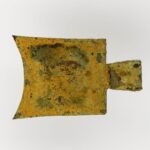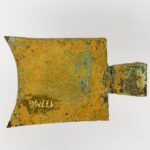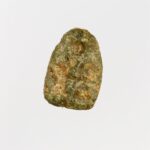Coin in the shape of a shovel
During the two periods of the Eastern Zhou Dynasty (770–256 B.C.), the Spring and Autumn Period (771–476 B.C.) and (in particular) the Warring States Period (475–221 B.C.), bronze money appeared in many forms, mostly miniature replicas of everyday objects such as shovels, knives, bells and other musical instruments, keys, clothes, and other types of weapons and tools. Each state of the fragmented Zhou dynasty territory minted its own money, which is why these coins are often referred to as “state coins” or guobu 國布 in Chinese numismatics. The most common types of coins, and the longest in circulation, were shovel-shaped coins (bubi 布幣 or buqian 布錢) and knife-shaped coins (daobi 刀幣 or daoqian 刀錢).
Shovels with a hollow stem, as in this photo, are the earliest of this type of coinage and usually date from the early Spring and Autumn Period. Shovel-shaped coins are clearly too small to be used as tools, ... more
During the two periods of the Eastern Zhou Dynasty (770–256 B.C.), the Spring and Autumn Period (771–476 B.C.) and (in particular) the Warring States Period (475–221 B.C.), bronze money appeared in many forms, mostly miniature replicas of everyday objects such as shovels, knives, bells and other musical instruments, keys, clothes, and other types of weapons and tools. Each state of the fragmented Zhou dynasty territory minted its own money, which is why these coins are often referred to as “state coins” or guobu 國布 in Chinese numismatics. The most common types of coins, and the longest in circulation, were shovel-shaped coins (bubi 布幣 or buqian 布錢) and knife-shaped coins (daobi 刀幣 or daoqian 刀錢).
Shovels with a hollow stem, as in this photo, are the earliest of this type of coinage and usually date from the early Spring and Autumn Period. Shovel-shaped coins are clearly too small to be used as tools, but a wooden handle can be inserted into the hollow stem as with a real shovel. In this way, they represent a very obvious link between the actual objects that characterised the daily life of archaic Chinese agrarian society and the custom of minting coins in the form of replicas. The coin depicted is one of the earliest examples of such a coin in the form of a spade with a hollow handle, or namcoin type. It most probably dates from between 650 and 400 B.C., but was presumably minted under the auspices of the central court of the Zhou dynasty. The coin is relatively well preserved, although the handle is missing. The surface is covered with a thin layer of corrosion and soil residue, indicating that it was an archaeological excavation. The three parallel vertical lines characteristic of these coins can still be seen on the reverse, but it is not entirely clear what the barely visible mark on the obverse could mean. It could be an archaic form of the character bai 百, which means “hundred” but at this point probably indicates the place of minting rather than the numerical value. (MG)







































Do you have a comment or additional information about the subject?